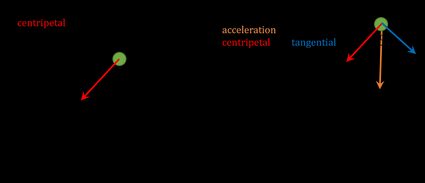How Do You Make Your Car Accelerate Faster
Centripetal acceleration and tangential acceleration
Acceleration is generally a vector, so you can always decompose it into components. Usually, we have two parts that are perpendicular to each other: the centripetal and the tangential. Centripetal acceleration changes the direction of the velocity, and therefore the shape of the track, but doesn't affect the value of the velocity. On the other hand, tangential acceleration is always perpendicular to the trajectory of motion. It changes the value of velocity only, and not its direction.
In a circular motion (the leftmost picture below) where an object moves around the circumference of a circle, there is only the centripetal component. An object will keep its speed at a constant value; think of the Earth that has centripetal acceleration due to the gravity of the Sun (in fact its speed changes a bit during a year - see orbital velocity calculator and orbital period calculator for more information).
When both components are present, the object's trajectory looks like the right picture. What happens if there is only tangential acceleration? Then linear motion occurs. This is similar to when you press down on the gas pedal in a car on a straight part of the freeway. And if you're a driver, our gas calculator might be of interest to you as well; it estimates the cost of car travel. You provide your fuel economy, distance and gas price and you'll quickly get the cost of the trip. There's even an option to split it with a few people, as traveling together is fun and beneficial! A group of talkative friends in your car will, e.g., prevent you from falling asleep.

Angular acceleration
Angular acceleration plays a vital role in the description of rotational motion. However, don't confuse it with the previously mentioned centripetal or tangential accelerations. This physical quantity corresponds to the rate of change of angular velocity. In other words, it tells you how fast an object's rotations accelerates - object spins faster and faster (or slower and slower if angular acceleration is less than zero).
Did you know that we can find an analogy between this and Newton's law of dynamics in rotational motion? In his second law, if you can switch acceleration with angular acceleration, force with torque and mass with moment of inertia, you'll end up with the angular acceleration equation. You might notice that some physical laws, like this one, are universal, which makes them really important in physics.
Gravitational acceleration
We mentioned acceleration due to gravity a few times earlier. It arises from the gravitational force that exists between every two objects that have mass (note that the gravity equation isn't dependent on an objects volume - only mass is essential here). It may sound weird at first, but according to the third Newton's law of motion, you act with the same force on the Earth as the Earth acts on you. However, the mass of the Earth is much bigger than a human mass (~10²² times bigger), so our impact on the Earth is pretty much zero. It's analogous to all the bacteria (~10¹⁸ times lighter than a human) living on your hand; you can't even notice them! On the other hand, we can feel the influence of our planet, and that's acceleration due to gravity.
Standard gravity is by definition 31.17405 ft/s² (9.80665 m/s²), so if a human weighs 220 lb (about 100 kg) he is subjected to the gravitational force of about 7000 pdl (1000 N). Let's enter this value to window #3 of our calculator along with the mass of the Earth (1.317 × 10²⁵ lbs or 5.972 × 10²⁴ kg in scientific notation). What is the calculated acceleration? It is so small that our calculator considers it to be zero. We mean nothing compared to the planet!
Particle accelerator
After talking about huge objects in space, let's move to the microscopic world of particles. Although we can't see them with our eyes, we have harnessed high energy particles, like electrons and protons, and use them regularly in particle accelerators; common in physics, chemistry, and medicine. We use them to kill cancer cells while sparing the surrounding healthy tissue or investigate a materials structure at the atomic scale. Recently, cancer is one of the diseases of affluence that probably result from the increasing wealth in society. Even poor nutrition can increase the risk of cancer! With this daily protein calculator you can check how much protein do you need a day and, if also want to get fit, our macro calculator is here to help you.
You probably know about the Large Hadron Collider (CERN), the most powerful particle accelerator in the world. It allows us to take a step further to understand how the universe works and develop technologies that may have many essential applications in the future. However, to achieve such high energies, we have to accelerate particles to the speeds that are close to the speed of light. Briefly, we can do it using magnetic or electric fields. To see how fast particles accelerate when compared to standard gravity, check out our acceleration in the electric field calculator, where we explained how to calculate the acceleration of charged particles.
The world of microscopic particles is ruled by statistical physics, which focuses specifically on the concept of probability. We've got many calculators related to this topic. Take a look at the probability calculator to learn how to find probability or try the permutation calculator to determine the number of ways in which you can order a certain amount of elements. Physicists use permutation to predict theoretical material properties that can be then observed in everyday life. For example, you can find out what is the average velocity of gas particles.
How Do You Make Your Car Accelerate Faster
Source: https://www.omnicalculator.com/physics/acceleration
0 Response to "How Do You Make Your Car Accelerate Faster"
Post a Comment